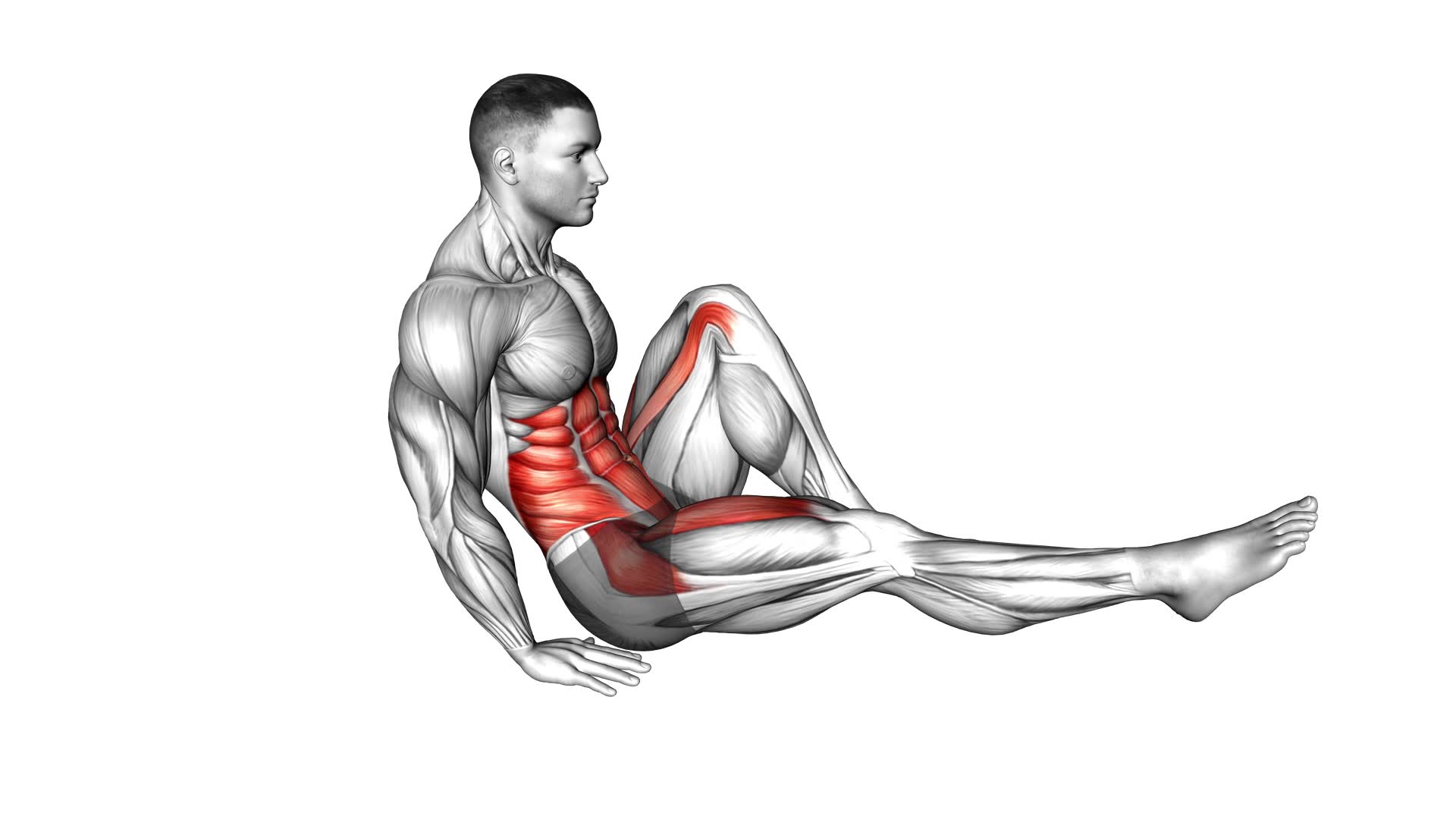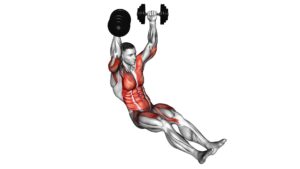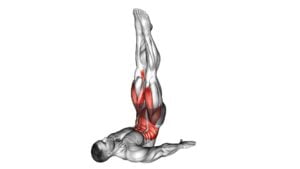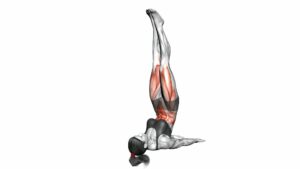Seated Alternate In Out Leg Raise on Floor – Video Exercise Guide & Tips

Are you looking for a quick and effective exercise to strengthen your legs? Look no further than the Seated Alternate In Out Leg Raise.
Watch This Exercise Video
This simple yet challenging movement targets your inner and outer thighs, helping you tone and define those muscles.
In this article, we will guide you through the proper form and technique, offer tips to avoid common mistakes, suggest variations to keep you engaged, and provide tips for increasing the intensity of your workout.
Let's get started!
Key Takeaways
- Seated alternate in out leg raise targets leg muscles, improves lower body strength and endurance, tones and strengthens leg muscles, and enhances balance and stability.
- Proper form and technique include performing leg raises slowly and with control, keeping the core engaged, avoiding jerking or swinging motions, maintaining a straight back, and ensuring smooth and controlled movements.
- Common mistakes to avoid include lifting legs too high, using momentum to swing legs, slouching or rounding the back, not engaging core muscles, and ignoring proper posture.
- Variations and modifications include weighted leg raises, single-leg raises, medicine ball squeezes, bicycle leg raises, and elevated leg raises.
Benefits of Seated Alternate In Out Leg Raise
You can experience several benefits from performing seated alternate in out leg raises. This exercise targets your leg muscles, specifically the quadriceps, hamstrings, and glutes. By regularly incorporating this exercise into your workout routine, you can improve your lower body strength and endurance.
One of the main benefits of seated alternate in out leg raises is that it helps to tone and strengthen your leg muscles. The movement engages multiple muscle groups, including the inner and outer thighs, which can help to create a more sculpted and defined appearance. Additionally, this exercise can also improve your balance and stability, as it requires you to engage your core muscles to maintain proper form.
To perform seated alternate in out leg raises correctly, start by sitting on a chair or bench with your back straight and feet flat on the floor. Lift one leg straight out in front of you, then bring it out to the side, and finally bring it back to the center. Repeat the movement on the other leg. Be sure to keep your core engaged and maintain a controlled motion throughout the exercise.
Proper Form and Technique
Maintaining proper form and technique is essential when performing seated alternate in out leg raises to maximize the benefits and prevent injury. To ensure you're performing this exercise correctly, it's important to understand the proper form and technique.
One common misconception is that you need to rush through the movement. However, it's crucial to perform the leg raises slowly and with control. This allows you to engage the muscles effectively and prevent any jerking or swinging motions that may lead to injury. Keep your movements smooth and controlled throughout the exercise.
Another key aspect of proper form is to keep your core engaged. This helps to stabilize your body and maintain balance during the leg raises. Keep your back straight and avoid arching or rounding your spine. By engaging your core, you'll also target your abdominal muscles, making this exercise more effective.
As you become more comfortable with the seated alternate in out leg raise, you can explore advanced variations. One option is to add ankle weights or resistance bands to increase the intensity of the exercise. This challenges your muscles even further and helps you progress in your fitness journey.
Common Mistakes to Avoid
To ensure proper form and technique during seated alternate in out leg raises, it's important to be aware of common mistakes to avoid.
By knowing what not to do, you can maximize the effectiveness of this exercise and reduce the risk of injury.
One common mistake is lifting your legs too high. When performing leg raises, it's crucial to keep the movement controlled and within a comfortable range of motion. Lifting your legs too high can strain your lower back and put unnecessary pressure on your hip flexors.
Another mistake is using momentum to swing your legs. This not only takes away from the targeted muscles but also increases the risk of injury. Instead, focus on engaging your core and using your abdominal muscles to lift and lower your legs.
Lastly, make sure to maintain proper posture throughout the exercise. Avoid slouching or rounding your back, as this can strain your spine. Keep your chest lifted and your shoulders relaxed.
Variations and Modifications
For different levels of difficulty, you can try variations and modifications of the seated alternate in out leg raise exercise. Here are five advanced modifications to challenge yourself and take your workout to the next level:
- Weighted Leg Raises: Hold a dumbbell or a weighted plate on your thighs while performing the leg raises. This added resistance will increase the intensity of the exercise and engage your muscles even more.
- Single-Leg Raises: Instead of alternating legs, perform the exercise with one leg at a time. This variation puts more focus on the working leg, making it more challenging to maintain balance and stability.
- Medicine Ball Squeezes: Place a medicine ball between your thighs and squeeze it tightly as you raise and lower your legs. This modification not only targets your lower abs but also engages your inner thigh muscles.
- Bicycle Leg Raises: Combine the seated alternate leg raise with a bicycle motion. As you raise one leg, twist your torso and touch the opposite elbow to the raised knee. This exercise adds a rotational element, engaging your obliques and improving core strength.
- Elevated Leg Raises: Sit on an elevated surface, such as a bench or step, and perform the leg raises. This modification increases the range of motion and requires more control and stability.
By incorporating these advanced modifications into your seated alternate in out leg raise routine, you can challenge your muscles in new ways and continue to progress towards your fitness goals.
Remember to always listen to your body and choose the variations that suit your fitness level and abilities.
Tips for Increasing Intensity
Increase the intensity of your seated alternate in out leg raise exercise by incorporating these tips.
To make the exercise more challenging, you can try adding ankle weights or using a resistance band around your ankles. This will provide additional resistance and engage your leg muscles even more.
Another way to increase intensity is by extending the duration of each repetition. Instead of doing quick movements, slow down and hold each leg raise for a few seconds before lowering it back down. This will help to build strength and endurance in your leg muscles.
In addition to modifying the exercise, proper breathing techniques can also enhance the intensity. Take a deep breath in before you start the leg raise, and exhale as you lift your leg and inhale as you lower it back down. This controlled breathing will help you maintain focus and stability throughout the exercise.
By incorporating these modifications and focusing on proper breathing, you can increase the intensity of your seated alternate in out leg raise exercise and challenge your leg muscles even further.
Now, let's explore how you can incorporate these leg raises into your workout routine to maximize their benefits.
Incorporating Seated Alternate in Out Leg Raises Into Your Workout Routine
Now that you understand the benefits of leg raises and the variations suitable for beginners, it's time to incorporate seated alternate in out leg raises into your workout routine.
These leg raises target your lower abs and hip flexors, helping to strengthen and tone your core.
Benefits of Leg Raises
Start by incorporating seated alternate in out leg raises into your workout routine to experience the benefits of this exercise. Here are some key advantages of leg raises:
- Muscle activation: Leg raises target and activate the muscles in your hip flexors, lower abs, and thighs, helping to strengthen and tone these areas.
- Core stability: As you perform leg raises, you engage your core muscles to maintain stability and control throughout the movement. This can improve your overall core strength and stability.
- Balance and coordination: Leg raises require balance and coordination as you lift and lower your legs in a controlled manner. Regular practice can enhance your balance and coordination skills.
- Lower back strength: Leg raises also engage your lower back muscles, helping to strengthen this area and improve your posture.
- Flexibility: Performing leg raises can help improve your flexibility in the hip and thigh muscles, allowing for greater range of motion.
By incorporating seated alternate in out leg raises into your workout routine, you can enjoy these benefits and take your fitness to the next level.
Now, let's explore some variations for beginners.
Variations for Beginners
To modify seated alternate in out leg raises for beginners, try incorporating a stability ball into your workout routine. This modification can help you build stability and strength in your core and lower body.
To perform the exercise with a stability ball, sit on the ball with your feet flat on the floor and your knees bent at a 90-degree angle. Place your hands on the sides of the ball for balance.
From this position, lift one leg off the ground and extend it out to the side, then bring it back to the starting position. Repeat with the other leg. Remember to engage your core and maintain proper form throughout the exercise.
This variation is a great way for beginners to gradually increase the difficulty of the seated alternate in out leg raise exercise while still maintaining proper form techniques.
Frequently Asked Questions
How Many Calories Does the Seated Alternate in Out Leg Raise Exercise Typically Burn?
Seated alternate in out leg raises can be a great exercise to burn calories and strengthen your leg muscles. When you perform this exercise, you engage multiple muscles in your legs, including your quadriceps and hamstrings.
The number of calories burned during this exercise can vary depending on factors like your weight and intensity of the workout. However, on average, you can expect to burn around 8-10 calories per minute doing seated alternate in out leg raises.
Can Seated Alternate in Out Leg Raises Help Improve Balance and Stability?
Seated alternate in out leg raises can definitely help improve your balance and stability. By engaging your core muscles and working on coordination, these exercises can increase your overall stability.
The alternating leg movements challenge your body to maintain balance and control, while also strengthening your core muscles. Incorporating this exercise into your routine can be a great way to improve your overall stability and increase your core strength.
Are There Any Modifications or Variations for Individuals With Limited Mobility or Injuries?
If you have limited mobility or injuries, there are modifications and variations for seated alternate in out leg raises. These modifications can help accommodate your specific needs and still allow you to engage in the exercise.
For limited mobility, you can try seated leg lifts with a smaller range of motion or use a resistance band for added support.
If you have injuries, it's important to consult with a healthcare professional for personalized modifications.
Is It Necessary to Use Any Equipment or Props While Performing Seated Alternate in Out Leg Raises?
No, you don't need any equipment or props to perform seated alternate in out leg raises. This exercise can be done on the floor without any additional tools.
It's a great way to strengthen your leg muscles and improve your flexibility. To do it properly, sit on the floor with your legs extended in front of you.
Lift one leg out to the side and then bring it back to the center. Repeat with the other leg.
How Often Should Seated Alternate in Out Leg Raises Be Incorporated Into a Workout Routine for Optimal Results?
For optimal results in your workout routine, it's important to incorporate seated alternate in out leg raises regularly. The frequency of this exercise depends on your fitness goals and current level of strength.
By including seated alternate in out leg raises in your routine, you can strengthen your leg muscles, improve balance, and enhance core stability.
Remember to consult with a fitness professional to determine the appropriate frequency that suits your needs.
Conclusion
Incorporating seated alternate in out leg raises into your workout routine can offer numerous benefits, including strengthening your core, hips, and thighs. By maintaining proper form and technique, you can avoid common mistakes and maximize the effectiveness of this exercise.
Additionally, by incorporating variations and modifications, you can tailor the exercise to your specific fitness level and goals. Remember to increase intensity gradually and always listen to your body to prevent injury.
Start incorporating this exercise into your routine and enjoy the benefits it brings.

Author
Years ago, the spark of my life’s passion ignited in my mind the moment I stepped into the local gym for the first time. The inaugural bead of perspiration, the initial endeavor, the very first surge of endorphins, and a sense of pride that washed over me post-workout marked the beginning of my deep-seated interest in strength sports, fitness, and sports nutrition. This very curiosity blossomed rapidly into a profound fascination, propelling me to earn a Master’s degree in Physical Education from the Academy of Physical Education in Krakow, followed by a Sports Manager diploma from the Jagiellonian University. My journey of growth led me to gain more specialized qualifications, such as being a certified personal trainer with a focus on sports dietetics, a lifeguard, and an instructor for wellness and corrective gymnastics. Theoretical knowledge paired seamlessly with practical experience, reinforcing my belief that the transformation of individuals under my guidance was also a reflection of my personal growth. This belief holds true even today. Each day, I strive to push the boundaries and explore new realms. These realms gently elevate me to greater heights. The unique combination of passion for my field and the continuous quest for growth fuels my drive to break new ground.







